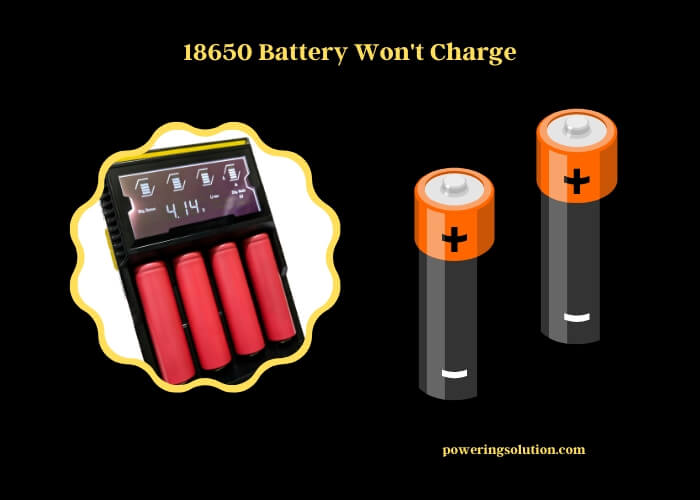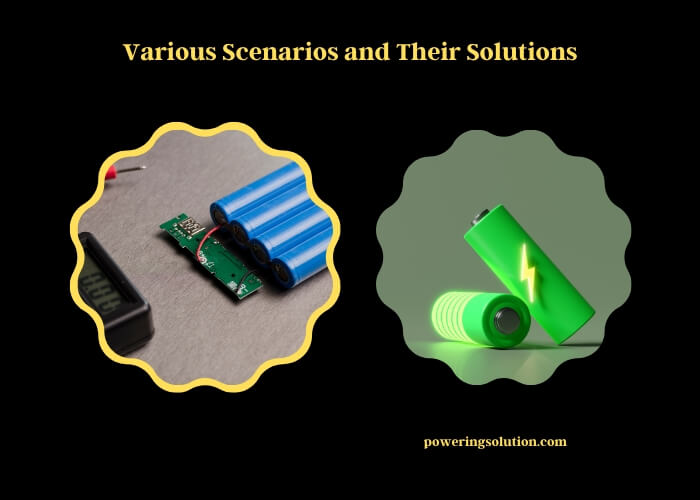If your 18650 battery won’t charge, it might be due to several reasons. The issue can be traced back to factors like over-discharge, faulty chargers, or even internal damage.
Lithium-ion 18650 batteries can face problems due to over-discharge. Draining the battery beyond a certain level can lead to charging issues, decreasing the overall lifespan of the battery. Proper management of charging cycles can help in avoiding such problems. A lithium-ion battery is best kept between 20% and 80% charge for most of its life.

A faulty charger can also be the culprit. Using low-quality chargers can potentially harm the battery and prevent it from charging properly. It’s always best to use the charger provided by the manufacturer or a well-reviewed alternative.
Internal damage in the 18650 battery can occur due to various reasons. It can be a result of an overheat situation, or due to a short-circuit within the battery. Heat can degrade the battery, thus reducing its charging capacity. Short-circuits, on the other hand, can directly hamper the battery’s ability to charge.
Poor contact between the battery and charger is often overlooked as a cause. Dust, dirt, or physical damage can affect the connection, preventing the battery from charging. Regular cleaning and careful handling of both the battery and charger can help mitigate this issue.
Lastly, the battery protection circuit, which safeguards the battery from issues like overcharging, over-discharging, and overheating, might be preventing the battery from charging if it detects a problem. So if your battery isn’t charging, it might be an indication of a more serious issue that the circuit is trying to prevent.
Prevalent Problems with 18650 Batteries
Several common problems may prevent your 18650 battery from charging correctly.
Issues of Overcharging and Over-Discharging
Overcharging or over-discharging can damage an 18650 battery, causing it to lose its capacity to hold a charge. Continual overcharging leads to capacity degradation and potential safety hazards. Conversely, over-discharging drops the battery voltage below its safe limit, creating issues with recharging.
Aging and Degradation of Battery Cells
Like all batteries, 18650 cells are subject to wear and tear. With age, they start losing their ability to hold a charge, resulting in decreased performance and potential charging problems.
Impact of Extreme Temperature Conditions
Extreme temperatures, both hot and cold, can have a negative impact on 18650 batteries. High temperatures can accelerate the aging process, while extremely low temperatures can impede the charging process.
Comparison of Issues Impacting 18650 Battery Charging
| Issue | Description | Impact |
| Overcharging/Over-discharging | Exceeding charge/discharge limits | Reduced capacity, Safety hazards |
| Aging | Natural wear and tear | Loss of capacity |
| Extreme Temperatures | Too hot or too cold | Accelerated aging or hindered charging |
Troubleshooting Your 18650 Battery Charging Issues
Before replacing your battery or charger, try these troubleshooting steps.
Assessing the Battery Voltage
An initial step in troubleshooting is checking the battery voltage. If it’s too low, your charger may not recognize it, preventing charging.
Evaluating the Charger’s Functionality
Check if your charger is functioning correctly by testing it with a different battery. If it charges the other battery successfully, your original battery may be at fault.
Testing for High Internal Resistance
A high internal resistance in the battery could be a sign of a defective or aged battery. This can be tested using a multimeter or battery analyzer.
Steps for Troubleshooting 18650 Battery Charging Issues
| Step | Method |
| Battery Voltage Assessment | Use a voltmeter |
| Charger Functionality Evaluation | Try a different battery |
| Test for High Internal Resistance | Use a multimeter or battery analyzer |
Various Scenarios and Their Solutions
Here are some scenarios you might encounter and how to resolve them.

Battery Over-Discharge Situation
If an 18650 battery won’t charge due to over-discharge, try recharging it slowly on a low current. It’s a safer approach, but note that not all over-discharged batteries can be revived.
Charger Failure
If the charger is at fault, consider replacing it with a high-quality charger compatible with your battery.
Aged or Damaged Battery
If your battery is old or damaged, replacing it is often the best solution. Continual usage of faulty batteries can pose safety risks.
Scenario-Based Troubleshooting Solutions
| Scenario | Solution |
| Over-Discharge | Slow recharge on a low current |
| Charger Failure | Replace with a high-quality charger |
| Aged or Damaged Battery | Replace the battery |
Guidelines for Seeking Professional Assistance
Sometimes, professional help is the safest and most efficient way to deal with battery issues.
Recognizing Serious Battery Problems
If your battery is swelling, leaking, or showing other signs of serious damage, seek immediate professional help.
Locating Dependable Battery Repair Services
Find a reliable battery repair service for help. Make sure they specialize in 18650 batteries to ensure accurate diagnosis and repairs.
Environmentally Responsible Battery Disposal
If your battery is beyond repair, dispose of it responsibly at a designated battery recycling center. Avoid throwing batteries in the trash as they contain hazardous materials.
Measures for Prevention
Prevention is better than cure. Take these steps to minimize the chances of your 18650 battery refusing to charge.
Best Practices for Battery Charging
Charge your battery at a moderate temperature, avoiding extreme heat or cold. Also, avoid overcharging and over-discharging.
Suggestions for Long-Term Battery Storage
For long-term storage, keep your battery at a 40%-60% charge in a cool, dry place. Full charges or complete discharges are not recommended for storage.
Regular Maintenance Recommendations
Regularly clean your battery contacts and keep an eye out for any physical damage. Consider investing in a battery analyzer to monitor your battery health.
Tips for Replacing Your 18650 Battery
When the time comes, it’s vital to know how to replace your 18650 battery properly.
Indications that Your Battery Needs Replacement
If your battery is no longer holding a charge or has significantly diminished capacity, it’s time to replace it.
Selecting a Quality Replacement Battery
Choose a reputable manufacturer for your new 18650 battery. Look for positive reviews and check the specifications to ensure compatibility with your device.
Disposing of Old Batteries Responsibly
Take your old batteries to a designated recycling center for safe disposal. Never throw them in regular trash bins.
Advanced Battery Care Techniques
Proper care can extend the lifespan of your 18650 battery and keep it in top shape.
Techniques for Maximizing Battery Life
Avoiding overcharging, over-discharging, and exposure to extreme temperatures can help maximize your battery life.
Monitoring Battery Health Over Time
Regularly checking your battery voltage and internal resistance can help you monitor its health and anticipate any upcoming issues.
FAQs
What Is the Ideal Time to Charge 18650 Batteries?
The best time to charge 18650 batteries is before they are completely drained. Aim to recharge them when they reach about 20-30% capacity. This practice helps prolong battery life.
What Could Cause a Ring Battery to Not Charge at All?
If your Ring battery is not charging at all, the duration for initial ring charging may be the culprit. Sometimes, a new Ring battery needs to be charged for an extended period before it will hold a full charge. Be sure to follow the manufacturer’s guidelines for charging to ensure optimal performance.
Could a Weak 18650 Battery Prevent Proper Charging?
Yes, a weak 18650 battery can prevent proper charging. Weak battery effects on engine may disrupt the charging process, leading to incomplete charging cycles and reduced overall battery performance. To ensure proper charging, it’s important to monitor the condition of the 18650 battery and address any issues promptly.
Can You Reset an 18650 Battery?
Resetting an 18650 battery is generally not advised, as it often involves dangerous methods like jump-starting. If your battery is not charging, the safe approach is to troubleshoot or replace it.
Which Battery Lasts Longer: 18650 or AAAA?
When it comes to longevity, the powerhouses of 18650 batteries certainly outlast their AAAA counterparts. While AAAA batteries are commonly used in smaller devices like stylus pens and Bluetooth headsets, 18650 batteries offer a superior lifespan. These larger rechargeable batteries are favored in high-drain applications such as laptops, flashlights, and electric vehicles, making them the clear winner in terms of lasting power.
Why Does My Li-Ion Battery Not Charge?
A Li-Ion battery might not charge due to various reasons – over-discharging, age and degradation of cells, charger failure, or exposure to extreme temperatures.
What Is a Current Interrupt Device (CID) in a Battery?
A Current Interrupt Device (CID) in a battery is a safety feature designed to disconnect the current in the event of an internal pressure increase, preventing potential failures or accidents.
What Is the Fully Charged Voltage for an 18650 Battery?
A fully charged 18650 battery typically has a voltage of 4.2 volts. It’s crucial not to exceed this voltage during charging, as it can lead to overcharging and battery damage.
Are There Specific Battery Chargers for 18650 Rechargeable Li-Ion Batteries?
Yes, there are specific chargers designed for 18650 rechargeable Li-Ion batteries. It’s advisable to use these chargers to ensure safe and efficient charging.
What Is a Protection Circuit in an 18650 Battery?
A protection circuit in an 18650 battery prevents overcharging, over-discharging, and short-circuiting. This feature helps enhance battery safety and longevity.
So, there could be multiple reasons why your 18650 battery won’t charge. From over-discharging and aging to charger failure and extreme temperature conditions, several factors could contribute to this problem. The aim is not to panic but to methodically troubleshoot the issue, using this guide as a reference. Remember, safety should always be your top priority, especially with items like batteries. And finally, if you’re unable to diagnose or solve the issue, don’t hesitate to seek professional help.
Read more:
